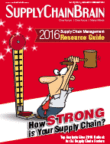
Visit Our Sponsors |
|
|
|
|
|
|
|
|
|
|
|
|
|
|
|
|
|
|
|
|
|
|
|
|
|
|
|
|
|
|
|
|
|
|
|
|
|
|
|
|
|
|
|
|
|
|
|
|
|
|
|
|
|
|
|
|
|
|
|
|
|
|
|
|
|
|
|
|

The Internet of Things is intersecting with supply chain along a number of dimensions:
1. Logistics - Sensors and intelligence are being added to vehicles, the yards, ports, and warehouses that goods travel through, the material handling equipment in those locations, and to the transportation lanes (roads, runways, railway, etc.), as well as directly on and within the loads they carry (the containers and products inside). These are being used to provide a number of new services and value in logistics processes, such as more precise ETAs and shipment tracking, much earlier warning about delays, smarter route optimization, intelligent congestion relief, stronger security (both in-transit and at-rest), predictive maintenance for better equipment up-time, improved safety of vehicles, condition monitoring of the loads (temperature for cold chain, shock and vibration, etc.), and increased fuel economy.
2. Service - IoT will have a huge impact on service. Sensors in products, vehicles and machines allows for predictive maintenance, enabling higher up-time at a lower cost. Technicians can be alerted by the machine before trouble happens, and know which parts and supplies to bring. Early warning allows better forecasting, dramatically reducing the amount of expediting of emergency parts required. Machines can reorder their own supplies. The data collected by machines allows companies to provide value-add services beyond just service and repair, such as improving productivity, reducing resource usage, increasing safety, etc. The same information is fed back to engineers and product managers, to improve product designs, and align each next generation better with how products are actually being used in the field.
3. Demand and Inventory Management - With embedded sensors and intelligence, connected products provide a wealth of new information about actual usage to companies. This enables much better forecasting of the needs, for consumables as well as for the full replacement or upgrade of the product. Item-level RFID has a proven ROI by providing much higher inventory accuracy enabling retailers to have the right quantity of the right products where they are needed. In addition, people are talking about using IoT (e.g., combing video, shopper tracking, and item tracking) in retail store settings to better understand shopper behavior (somewhat like the way websites can track the clickstream of shoppers on the site) and provide much better targeted marketing, as well as improving the merchandising and layout of the store.
4. Supply Chain Risk Management - Instrumentation of manufacturing plants and warehouses, vehicles, and loads, combined with other intelligence (e.g. weather) and monitoring of events (e.g. strikes, natural disasters, etc.), allows proactive warning of risks in the supply chain and a very granular understanding of their impact on your specific products.
5. Product-as-a-Service - Some manufacturers are moving to new business models where they retain ownership of the product and sell the outcome as a service instead of selling the thing itself. This changes the dynamics of the supply chain, adding predictability to the chain and incentivizing manufacturers to build products that last much longer and require fewer repairs.
Collectively, these IoT-driven impacts represent profound changes to how supply chains are operated.
The Outlook
Leaders have already been experimenting with these capabilities and will begin scaling out the programs that they’ve been piloting. Fast followers will begin planning or actually executing pilots.
RELATED CONTENT
RELATED VIDEOS
Timely, incisive articles delivered directly to your inbox.






